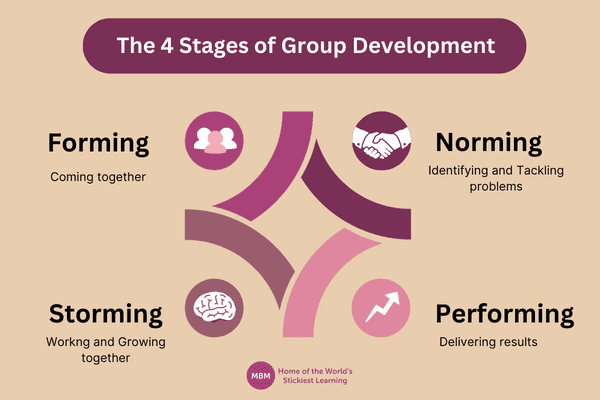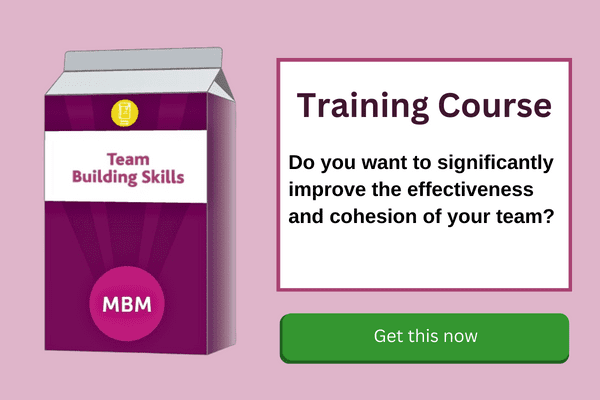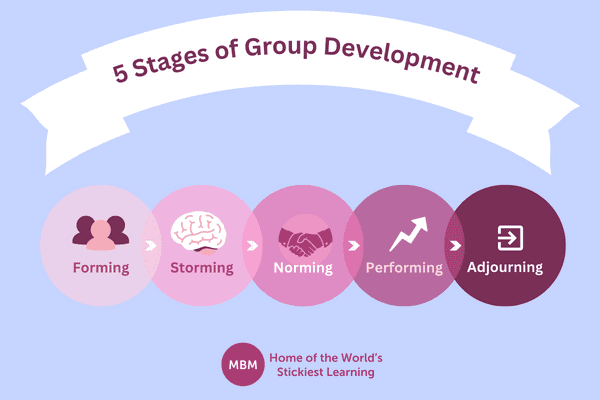Know How Teams Develop, and Jump-start Your Journey to Success
‘Forming, storming, norming and performing,’ the snappy rhyming names Bruce Tuckman gave the different stages in his theory, “Tuckman’s stages of group development,” have established him as a leading expert in the field. First published in 1965, Tuckman’s theory is still the major work on the lifecycles of work groups and project teams.
Don’t underestimate it just because Tuckman’s stages rhyme as they do. Grasping Tuckman’s underlying thinking will help you bring teams together quicker, reach the required performance level sooner, and then stay there.
What Are the 4 Stages of Group Development?
At any point in a work group’s existence, you need to know your people’s expertise and experience and judge the best leadership style to adopt to get the results you require. That’s a given. But here’s the thing. You’ll make your task easier, and life more enjoyable for everyone, if you understand something of the psychology of what your team is going through.
With that said, the four stages of group development in Tuckman’s theory are:

- Forming: Coming together.
- Storming: Growing together, overcoming differences, and facing up to the challenges of working together.
- Norming: Getting down to the business of identifying and tackling the problems.
- Performing: Finding feasible solutions, planning the work, and delivering results.
Bruce Tuckman was an American psychological researcher specialising in the study of group dynamics. In 1965, he published his theory entitled “Tuckman’s stages of group development,” also known as Tuckman’s Model.
In Tuckman’s theory, he identified the four stages, Forming, Storming, Norming and Performing, which he maintained are all necessary and inevitable. He added a fifth and final stage in 1977, but we’ll come to that later. For now, let’s focus on these four stages.
Team leaders and managers need to understand how teams mature, and when to intervene when things aren’t progressing as desired. Business models go in and out of fashion, but over 50 years later, companies of all kinds, including tech ones, still use Tuckman’s model to manage projects, run cross-company working groups, and transform core processes.
Let’s Take a Closer Look at the Forming, Storming, Norming and Performing Stages

The Forming, Storming, Norming and Performing model explains that as the team develops maturity and ability relationships are established. Also, the prevailing leadership style changes to more collaborative or shared leadership.
The following are snapshot scenarios of what can happen in each stage to give a flavour of why Tuckman’s model is so important. Picking up Judith Stein’s point about the four stages being useful as a basis for team conversation, there’s a clear benefit from talking them through with the team early on. Here, we look at the leader’s role, typical behaviours, possible emotional reactions/responses, and actions to take when managing the group.
First, What Happens in the Forming Stage?
So, our first stage in forming, storming, norming and performing, is bringing the group together. Here are the common areas we see at this stage.
Sticky Learning ® is 7 times more effective than 1-day training courses. Plus, you will get a Chain of Evidence proving your Return on Investment. Discover soft skills training that changes behaviours long term.

Leader’s Role
- First, the team has a high dependence on the leader for guidance and direction.
- Also, the leader must be prepared to answer questions about the team’s purpose, objectives, and relationships with external people. They may ignore existing processes, and not think beyond the immediate task.
- Next, the leader needs to direct the team and set the rules.
Typical Behaviours
- There’s little agreement on team objectives, other than those set by the leader.
- Individual roles and responsibilities aren’t clear.
- Members test the tolerance of both the system and the leader.
- Interactions are more formal than at later stages.
Possible Emotional Reactions/Responses
- High levels of excitement and enthusiasm.
- Levels of anxiety about the unknown of the new project/team formation.
- Nervousness about sharing with the group due to lack of familiarity.
Action to Take
As the leader:
- Widen the conversation about why you’re all there and what the mission is.
- Additionally, set out the ground rules.
- Also, state clearly what are the expected team norms while reviewing your expectations for how they should work together.
Hopefully, in most businesses, people in work teams will show more maturity, individual initiative, leadership potential, self-management, and a sense of responsibility than this description of the Forming stage suggests. Treating employees as adults, and showing respect for them as people, is always advisable! But the most important thing for leaders is to be open and self-aware and listen.
Now, What Happens in the Storming Stage?
Now we have the second stage of the forming, storming, norming and performing model where the group start growing through challenging the original behaviours and ideas from our first stage.
Leader’s Role
- The leader increasingly coaches, with less need for authoritative leadership.
- Leaders need to manage conflict and discord head-on.
- Here, leaders coach the group through their differences.
Typical Behaviours
- First, there’s a lack of agreement about making group decisions.
- Also, team members attempt to establish themselves and their position concerning other team members.
- Now, the group may challenge the leader’s authority.
- And, the team’s purpose becomes clearer, but uncertainties persist.
- Then, cliques and factions form in the group. This may lead to power struggles.
Possible Emotional Reactions/Responses
- Elements of negativity due to a lack of clarity and direction.
- Resentment towards anyone in the group as favourable treatment.
- Feel defensive when their ideas/suggestions are challenged.
- Confusion about the “how”, “what”, “who”, and “why”.
Action to Take
As the leader:
- Now, get the team to focus on its goals, to avoid being distracted by individual working relationships and emotional issues.
- Also, encourage compromises to enable progress, as required.
- Then, break big goals into bite-size pieces, creating better clarity of how bigger targets will be achieved.
- Also, work with the team to redefine their roles.
- Next, encourage personal autonomy and responsibility by helping individuals flex or develop work-related and leadership skills.
- Finally, promote problem-solving as a group to gain better levels of consensus.
Remember, this stage doesn’t last forever. Your main role as a leader is to manage the situations as they arise. Also, focus on getting agreement happening within the group. Remind them of their ultimate goals and objectives as a group.

Next, What Happens in the Norming Stage?
Here, we’re seeing a positive change in the group’s dynamic. In terms of the forming, storming, norming and performing model, this stage settles the group into a functioning unit. So, let’s see how it looks.
Leader’s Role
- Ideally, you get to participate more with the group.
- Also, less direction and management are needed with the group functioning better as a team.
- Additionally, develop set processes for the group to follow in terms of communication channels, sharing feedback, distribution of resources, and other areas.
Typical Behaviours
- Agreement and consensus become established among the team, who respond well to the leader acting more like a facilitator.
- Roles and responsibilities are clear and accepted.
- Big decisions are made by group agreement. Smaller ones may be delegated to individuals or small teams within the group.
- Commitment and unity are strong. By now, the team are comfortable enough with each other to engage in social activities.
- The team discusses and develops the processes and working styles.
Possible Emotional Reactions/Responses
- Sense of belonging.
- Confidence increases.
- Acceptance of others in the team.
- Increase trust and collaboration.
Action to Take
As the leader:
- Here, you promote team interactions and collaboration.
- Then, encourage others to take leadership roles.
- Also, recognise contributions and provide feedback.
- Now, encourage others to make decisions.
- Also, let the group work things out.
- Gently encourage team members to engage in self-evaluation.
- Determine whether there’s room for improvement.
- Finally, keep your prime focus on encouraging stability.
Actually, at this stage, a lot of work is happening. The project or task really starts to take shape. People in the group can see progress. As a result, we see increased motivation and enthusiasm.
Then, What Happens in the Performing Stage?
Here, we see part 4 of the forming, storming, norming and performing model. Now, this is where we want to be. Actually, getting to this point is a great achievement for everyone involved. We see:
Leader’s Role
- Lead from the back, and allow others to take the lead.
- Understand and respect the knowledge and skills of others.
- Collaborate with the group to ensure success.
Typical Behaviours
- First, the team has an increased sense of strategic awareness. It’s clear why they’re doing all this.
- Also, there’s a shared vision. The team is now independent and doesn’t need hands-on supervision from the leader.
- The focus is on outperformance and over-achieving goals.
- Then, the team makes most of the decisions, against criteria agreed upon with the leader. They have a high degree of autonomy.
- However, disagreements still occur, but are resolved positively within the team, which makes necessary changes to processes and structure.
- Ideally, the team works towards achieving the goal and attends to issues with working relationships, management styles, and processes as they arise.
- Also, team members support each other.
- Finally, team members seek assistance from the leader with their personal and interpersonal development.
Possible Emotional Reactions/Responses
- Display confidence.
- Shows empathy.
- Tight connections are created.
- Display high levels of commitment.
Action to Take
As the leader:
- Delegate tasks and subprojects, rather than giving orders.
- Share leadership decisions with others.
- Look at future projects and tasks the team can work on.
- Celebrate the successes of the team.
Wow, we did it! Here, we see everyone working at full throttle and making magic happen. However, remember the magic doesn’t last without amazing effort. And, it doesn’t last forever. We naturally revert to previous stages if the momentum isn’t maintained with regular upkeep.
So What Are the 5 Stages of Group Development?
As we’ve said, in Tuckman’s original 1965 theory, he identified four stages; forming, storming, norming and performing:
- Forming – team orientation.
- Storming – power struggle.
- Norming – cooperation, integration, and unity.
- Performing – synergy.
In 1977 Tuckman, together with Mary Ann C. Jensen, who reviewed his earlier paper, added a fifth stage, ‘Adjourning.’

Finally, What Happens in the Adjourning Stage?
Adding on to the original 4 stages of forming, storming, norming and performing, we see the adjourning stage. Finally, a sense of closure characterises this stage and we see the following.
Leader’s Role
- Encourage reflection of the experience.
- Support the forward movement of the team collaboration.
Typical Behaviours
- Sometimes, the workload slowly diminishes.
- By now, most of the project goals are completed.
- Also, people are working on leftover tasks.
- Slowly, team members are gradually allocated to different teams and projects.
Possible Emotional Reactions/Responses
At this stage, for one-off projects and events, you see:
- Relief that it’s over.
- Resignation that the team will disband.
- Disappointment that the project is over.
Action to Take
As the leader:
- Encourage the team about future projects/tasks.
- Celebrate success.
- Evaluate the process, barriers, and opportunities.
By including the Adjourning stage, Tuckman wanted to complete the process of group development and provide teams with a stage for reflection on what they have accomplished with their project.
If the team is a standing group, new people come in to replace existing members. The team goes back to a forming or storming stage and the cycle starts all over again, but hopefully with lessons learnt and procedures improved.
Forming, Storming, Norming, Performing – Get The Picture
This chart shows how in Tuckman’s Model, the team’s focus on the task varies over time as relationships develop in the different phases of forming, storming, norming, and performing.

The important point is that after the honeymoon stage of forming, in the storming stage, the focus on the task is likely to dip as seen here. Differences in attitude, experience, outlook and working culture will likely distract people from the job before they settle down and work together.
Diverse businesses and global teams clearly benefit from diversity, through the fresh and varied thinking it brings. But when teams are getting used to working together, these differences can be disruptive. As our article on Betari’s Box confirms, in the Storming stage leaders and managers can break the attitude-behaviour cycle and resolve conflicts by being compassionate and taking a positive attitude when people are being difficult.
What Does Tuckman’s Theory explain?
The ‘Forming, Storming, Norming, Performing’ theory is an elegant and helpful explanation of team development and behaviour. Like the Tannenbaum and Schmidt Continuum, which developed around the same time, Tuckman’s theory shows how teams grow and members develop as the leader gradually feels more able to relax their grip and allow team members greater individual authority and freedom.
Tuckman’s model explains that as the team develops maturity and ability, relationships are established, and the leader changes leadership style. It begins with a directing style, moving through coaching, then participating, and finishing with delegation, at which point the team are almost detached. At this point, the team may produce a successor leader, and the previous leader can move on to develop a new team and restart the cycle.
Come On, Team, Recognise Your Feelings!
Understanding why things happen in certain ways in a team is a valuable part of the necessary self-evaluation process. Hence, Tuckman’s four stages prove most useful as a basis for team conversations.
Just as human development isn’t always linear, teams don’t always develop in straight lines. Referring to these stages to help identify and understand the causes of changes in team behaviours, can help the team optimise its process and productivity.
Examples of the Stages in Action

We talked before about how each stage of team development has its own recognisable feelings and behaviours. Let’s look at how these stages can look in real-life examples.
#1: Training Programme Including Interdepartmental Participants
Personally, I have experienced this over the years from my role in L&D. I have seen first-hand these group dynamics while running interdepartmental leadership training courses. The same applies if you’re leading a project involving people from different departments or sections of the company. Let’s review how they get on through the forming, storming, norming and performing stages of the course.
Forming
So, on day one of the course, the group acts/behaves in more reserved ways. So they:
- Follow your instructions without too many questions or doubts.
- Hesitate to answer questions, even when they know the answers.
- Try to get a feel of the room and the other participants.
- Usually, stick with the people most familiar to them when choosing their seats and during breaks.
- Follow natural leadership roles in group activities and discussions.
Remember, they do know each other. However, you have them in a different environment and group dynamic. They need this initial time to settle in and understand the atmosphere, getting to know what is safe to share and when.
Storming
By the second or third session or day, the group is more familiar with each other and some of the nervousness starts to go away, especially from the quieter members. We see that they:
- Start to question more regarding the topic and the trainer’s input.
- Actively participate more in group activities and discussions.
- Disagree more on opinions and ideas that are shared in the group.
- Challenge the group hierarchy more readily.
- Defend their opinions and input more passionately.
So, this shift is necessary for all participants to feel included. At the end of the day, everyone needs to be involved for the learning process to happen. As a leader, challenge any of the passive participants to take part more. Involve them on a rotation basis so everyone has a say and is included. Also, avoid leaders attending from taking over all the time. That way you are evening the playing field for everyone.
Norming
Now, we’re halfway through the course and they are familiar with the group dynamic. So what we see here is:
- More consensus during discussions and activities.
- Increased positivity and enjoyment in the group.
- Better interaction between participants who were less familiar with each other before the course started.
- Willingness to work together as a group and participate actively in the sessions.
Naturally, the group has become more comfortable with each other and is used to sharing. They have found their rhythm; you can facilitate more instead of having to direct or manage them.
Performing
At this stage of the group development, I have witnessed great bonds and friendships developing due to their time together. Here, they:
- Offer assistance and help to other members of the team.
- Work together to achieve success in their activities.
- Ensure nobody is excluded at any time.
- Intermingle with ease throughout the group.
- Recognise the knowledge and skills of everyone participating.
Adjourning
And now, the course has come to an end. Many in the group will:
- Commit to the connections they created during the course.
- Reflect on the experience they had with the others.
- Ensure the bonds they create will carry over into their work roles.
This will sound familiar to many of you who have had a similar experience.
#2: Having Different Team Members at Different Stages at Once
From experience, I have encountered the forming, storming, norming and performing stages actively working side-by-side in our everyday teams. Let’s see how it looks.
Forming
Here, you have new joiners, trainees, and newly promoted team members. Remember the descriptions we gave earlier of the behaviours you will see. New Joiners and newly promoted employees will:
- Follow the lead of others more experienced than they are.
- Avoid voicing their own opinions based on being new to the team/role.
- Show great enthusiasm and energy to their new role to prove themselves.
This new infusion of energy can have mixed responses; energising others or resentment from pre-existing team members.
Storming
Unfortunately, this stage is seen too much in our workplace. People at this stage simply spread negativity throughout the team. In fact, they can be at any stage of their time with the company. Here, we see that they:
- Complain about the company, conditions, and leadership despite receiving all of the benefits of employment.
- Encourage others to voice their negativity, even if they don’t have grievances.
- Challenge change or decision they are not actively involved in.
We all have these people in our team. First, share positivity to counteract the negativity being shared. Next, challenge the individual about what is happening and why they feel this way. Also, promote teamwork and collaboration to build trust and respect in the team. Finally, use your disciplinary process, in terms of counselling, to create open conversations that turn complaints into opportunities for improvement.
Norming
Next, we have the pillars of our team that we can’t do without. They come and perform, sometimes above and beyond, but not regularly. We see that they:
- Often, complete their tasks as expected.
- Frequently, work well with others.
- Follow the standards and processes as per the guidelines.
- Have complaints, however, they don’t become aggressive or toxic.
These members of the team are reliable and trustworthy. However, they can be swayed by the “storming” members. Watch out for that and be available to support your “normers”.
Performing
Now, these performers are your stars. These are the ones who go above and beyond consistently. Think of your team, and who is the one that stands out? We all have them, however we don’t always appreciate them.
- Use your recognition programme to acknowledge their contribution.
- Suggest them for leadership/supervisory development programmes.
- Create a development programme that supports their growth in the company.
Please, never underestimate the importance of our “performers” as they make everything happen. So, use them as the buddies for new joiners. Also, create situations that allow these “performers” to continue to shine. Finally, utilise the energy and positivity of your performers to encourage others.
Adjourning
So here are “the leavers”. Nobody likes to lose a team member (unless they are constant “stormers”!). However, it is part of the life cycle of the employment journey.
Ensure that:
- The employee leaving is leaving on a positive note.
- We have started looking for replacements.
- The fit will work well with the existing team members.
- You acknowledge that change happens.
Enjoyed this article? Show your appreciation by supporting us on Linkedin.
Updated: March 2024 by Ailish O’Rourke-Henriette




